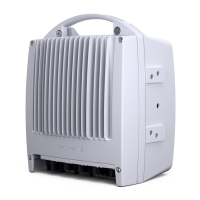MINI-LINKEandEMicro
Similarly, the outgoing signals are multiplexed in the cable interface: receiving
IF signal and com mand and control signal down-link.
• The nominal frequency of the receiving IF signal is 140 MH z.
• The command and control signal down-link is an ASK modulated signal
with a nominal frequency of 4.5 MHz.
In addition to the above, the cable interface includes an overvoltage protection
circuit.
3.5.2.3 Control and Supervision Processor
The processor for radio unit control and supervision is situated on the
microwave unit circuit board. Its main functions are described below.
Alarm Collection
Collected alarms and status signals from the radio unit are sent to the indoor
MMU processor. Summary status signals are visualized by LEDs on the radio
unit.
Command Handling
Commands from the indoor units are executed. These commands include
transmitter activation/deactivation, channel frequency settings, output power
settings and RF loop activation/deactivation.
Radio Unit Control and Message Handling
The processor also controls the radio unit’s internal processes and loops.
3.5.2.4 Transmit IF Signal Processing
The transmit IF signal is amplified, limited and demodulated. The demodulated
signal is amplified and passed through a buffer amplifier to the transmitter MCM
for modulation onto the RF carrier.
The level is used to generate an alarm, indicating that the t ransmit IF signal
level is too low due to excessive cable losses.
The input amplifier is automatically gain-controll ed so that no compensation is
required due to the cable length between indoor and outdoor equipment.
37
AE/LZT 110 2012 R8C 2002- 03-04

